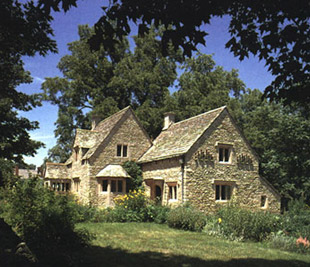 |
|
| |
|||||||
|
|||||||
|
|||||||
ROSE COTTAGE - A SOUVENIR FROM ENGLAND-- MORE Rose Cottage probably dates from the 1600's, a relative newcomer in Chedworth, a village first mentioned in the year 854. Even when new the cottage was a fairly humble structure, providing shelter to several generations of families whose concerns centered more on survival and livelihood than enjoying 'country living'. For centuries occupations throughout the Cotswold region centered around sheep farming, textiles, and quarrying. Records of the cottage's inhabitants are incomplete, but during the 1800's it was apparently occupied by a family named Smith who quarried stone and were stone masons. The architecture of the region is the result of both the versatility and limitations of the local limestone. The cottage includes characteristic Cotswold architectural elements - tall gables, steep roofs, and stone-framed windows - but their placement and appealing proportions are a result of the builder's grasp of the limestone's strength rather than a self-conscious style. Practical constraints have resulted in a pleasing architecture that seems to characterize an idealized way of life. The restful image of a picturesque cottage nestled in a colorful garden is actually quite modern and Rose cottage's evocative name dates only from the 1920's. Set down in Dearborn Michigan like a transplanted piece of England, Rose cottage continues to weave a subtle spell - perhaps J. B. Priestley, writing about Cotswold houses in his English Journey, captured the essence of this charm:
|
| Copyright © The Henry Ford ~ http://www.TheHenryFord.org |

